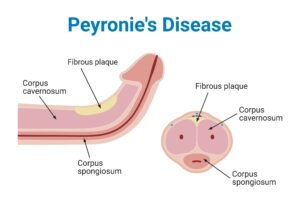Peyronie's Disease Treatment in Los Angeles & San Francisco

Slightly curved penises are common and usually not a cause for concern. But when the curving is more than 20 degrees off of the midline, appears to worsen or is accompanied by penile pain, it may be indicative of a condition called Peyronie’s disease. It occurs in about 10 percent of men over the age of 50, and increases with age.
Overcome the Pain and Discomfort of Peyronie’s Disease
Peyronie’s disease causes curvature or bending of the penis, which can make it difficult or impossible to have intercourse. Many men with Peyronie’s disease can also have painful erections and have trouble achieving or maintaining an erection. As Dr Turek has published, this can have significant psychological side effects on men affected by it.
If you have Peyronie’s disease, you might feel stressed or anxious at the thought of being intimate, or frustrated by how it interferes with sexual performance and pleasure. It may also be challenging to conceive when intercourse is difficult.
There is no reason to suffer the discomfort, stress or frustration of Peyronie’s disease in silence. Peyronie’s disease is treatable with board-certified urologist and men’s sexual health expert Dr. Paul Turek. His keen understanding of Peyronie’s disease has helped many men find relief from painful erections and enjoy satisfying sex lives.
What Causes Peyronie’s Disease?
Peyronie’s disease occurs when fibrous scar tissue, or plaque, forms within the wall of the penis. This can cause a firm, flat lump that can be felt under the penile skin and may or may not cause pain with erections. The plaque also makes the connective tissue inside the penis less flexible than normal, which causes the penis to curve or bend in the direction of the plaque.
Most of the time, Peyronie’s disease occurs in men ages 40 and older, although it can develop at any age.
The exact cause of Peyronie’s disease is not fully understood. Some cases of Peyronie’s disease are thought to be genetic in nature and are associated with a bent or “trigger finger” on the hand. Other cases are due to instances of injury or trauma to the penis. Still others appear to occur over time with routine sexual activity.
Before beginning treatment, Dr. Turek performs a careful physical exam of the penis and asks detailed questions about the duration and frequency of symptoms, along with taking a complete medical history. He may order an ultrasound to determine the location and density of the plaque, look for calcium buildup and evaluate blood flow in the penis.
How Dr. Turek Treats Peyronie’s Disease

In mild cases of Peyronie’s disease, where the curvature is not getting worse, erections and sex are not painful and erectile function is good, Dr. Turek may recommend watching the condition. In approximately 13 percent of cases, Peyronie’s disease goes away on its own.
But if Peyronie’s disease does not resolve by itself, and pain and other symptoms persist, there are treatment options. Dr. Turek believes in trying the least invasive methods first, before proceeding to surgical measures.
Drug therapy may be helpful to dissolve the plaque to straighten out the penis. Medications can be taken orally or injected directly into the plaque. In the most severe cases of Peyronie’s disease, surgery may be recommended. Surgery is used only after the condition has been stable for at least six months and after pain has resolved. The type of surgery depends on the exact condition.
There are three surgical approaches to treating Peyronie’s disease:
- Shorten the side of the penis opposite to the plaque
- Remove the plaque and replace it with a graft
- Place a penile implant to straighten the penis
Peyronie’s Disease FAQs
 Can Peyronie’s disease cause infertility?
Can Peyronie’s disease cause infertility?
Peyronie’s disease affects the structure of the penis, not the testicles, so it doesn’t directly cause infertility. However, for some men, severe curvature of the penis or an associated issue with erectile dysfunction can interfere with sexual intercourse, which may make it harder to conceive naturally.
Does Peyronie’s disease affect urination?
In most cases, Peyronie’s disease doesn’t affect urination because the plaque or scar tissue forms in the tunica albuginea within the body of the penis, and not the urethra. Since the Peyronies-associated penile curvature occurs only with erections and urination typically happens with a flaccid penis, there is no discomfort during urination.
Can Peyronie’s disease be prevented?
There’s no guaranteed way to prevent Peyronie’s disease, as its cause is not always known. That said, minimizing penile trauma (such as with aggressive sexual activity or the use of constricting sex toys) may reduce risk. Maintaining your overall vascular health with good diet, exercise, and properly treating medical conditions such as high blood pressure and diabetes can also help.
What happens if Peyronie’s disease is left untreated?
For some men, the condition may stabilize an occasionally improve without treatment. But for others, the plaque can worsen, causing increasing curvature, pain, or shortening of the penis. In advanced cases, it may lead to both difficulty with erections and sexual activity. That’s why early evaluation by a urologist like Dr. Turek is a smart move.
What is penile traction therapy, and does it work?
Penile traction therapy uses a medical device to stretch the penis gently over time. It’s been shown in studies to help reduce curvature and, in some cases, lengthen the penis. It’s a non-surgical option that is performed at home and is typically used early in the disease process or combined with other treatments.
Are there exercises or stretches that can help Peyronie’s disease?
Outside of penile traction therapy, there aren’t any proven exercises or stretches that reliably treat Peyronie’s disease. Be aware that random at-home stretches may potentially worsen the condition, so men should talk to Dr. Turek before trying any type of “DIY” therapy.
What is the recovery time after Peyronie’s disease surgery?
Most men recover from surgical correction (such as plication or grafting procedures) in about 4 to 6 weeks. Normal daily activities can usually be resumed after a couple of weeks, but sexual activity typically needs to wait until full healing occurs — usually around 6 weeks or as advised by Dr. Turek.
Can Peyronie’s disease come back after treatment?
Yes, there is a chance of recurrence, as it can be a progressive problem in some cases, especially if the condition is severe or if risk factors like diabetes, smoking, or penile trauma aren’t addressed.
How can I maintain my results after Peyronie’s disease treatment?
Good penile care after treatment matters. Avoiding trauma, maintaining vascular health, following your doctor’s instructions, and using traction therapy when recommended can all help maintain results and reduce the risk of recurrence.
What is the success rate of Peyronie’s disease treatments?
Success depends on the treatment and severity of the condition. Oral medications and penile injections have shown moderate success in reducing curvature and improving function in milder cases. Shockwave therapy is considering experimental and has variable results. Penile traction devices also show promising results when used consistently. Surgery has the highest success rates, typically over 85%, for straightening the penis, particularly in severe cases.
Contact The Turek Clinic
If you are frustrated by your curved penis’s effect on your sexual function and your overall quality of life, Dr. Turek can help. He has been treating this complex disease for a long time and has seen great success. Please contact The Turek Clinic to schedule your visit today.









